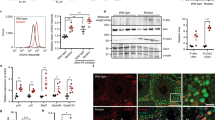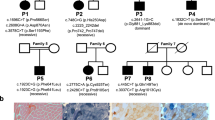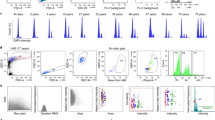Abstract
Mitochondrial DNA (mtDNA) deletions are a primary cause of mitochondrial disease and are likely to have a central role in the aging of postmitotic tissues. Understanding the mechanism of the formation and subsequent clonal expansion of these mtDNA deletions is an essential first step in trying to prevent their occurrence. We review the previous literature and recent results from our own laboratories, and conclude that mtDNA deletions are most likely to occur during repair of damaged mtDNA rather than during replication. This conclusion has important implications for prevention of mtDNA disease and, potentially, for our understanding of the aging process.
This is a preview of subscription content, access via your institution
Access options
Subscribe to this journal
Receive 12 print issues and online access
$209.00 per year
only $17.42 per issue
Buy this article
- Purchase on Springer Link
- Instant access to full article PDF
Prices may be subject to local taxes which are calculated during checkout





Similar content being viewed by others
References
Holt, I.J., Harding, A.E. & Morgan-Hughes, J.A. Deletions of muscle mitochondrial DNA in patients with mitochondrial myopathies. Nature 331, 717–719 (1988).
Shoffner, J.M. et al. Spontaneous Kearns-Sayre/chronic external ophthalmoplegia plus syndrome associated with a mitochondrial DNA deletion: a slip-replication model and metabolic therapy. Proc. Natl. Acad. Sci. USA 86, 7952–7956 (1989).
Goto, Y., Nonaka, I. & Horai, S. A mutation in the tRNA(Leu)(UUR) gene associated with the MELAS subgroup of mitochondrial encephalomyopathies. Nature 348, 651–653 (1990).
Wallace, D.C. et al. Familial mitochondrial encephalomyopathy (MERRF): genetic, pathophysiological, and biochemical characterization of a mitochondrial DNA disease. Cell 55, 601–610 (1988).
Schaefer, A.M. et al. The prevalence of mitochondrial DNA disease in adults. Ann. Neurol. 63, 35–39 (2008).
Taylor, R.W. & Turnbull, D.M. Mitochondrial DNA mutations in human disease. Nat. Rev. Genet. 6, 389–402 (2005).
Hudson, G. & Chinnery, P.F. Mitochondrial DNA polymerase-gamma and human disease. Human Molecular Genetics 15 (Spec. No. 2), R244–252 (2006).
Bender, A. et al. High levels of mitochondrial DNA deletions in substantia nigra neurons in aging and Parkinson disease. Nat. Genet. 38, 515–517 (2006).
Kraytsberg, Y. et al. Mitochondrial DNA deletions are abundant and cause functional impairment in aged human substantia nigra neurons. Nat. Genet. 38, 518–520 (2006).
Sciacco, M., Bonilla, E., Schon, E.A., DiMauro, S. & Moraes, C.T. Distribution of wild-type and common deletion forms of mtDNA in normal and respiration-deficient muscle fibers from patients with mitochondrial myopathy. Hum. Mol. Genet. 3, 13–19 (1994).
Bua, E. et al. Mitochondrial DNA-deletion mutations accumulate intracellularly to detrimental levels in aged human skeletal muscle fibers. Am. J. Hum. Genet. 79, 469–480 (2006).
Samuels, D.C., Schon, E.A. & Chinnery, P.F. Two direct repeats cause most human mtDNA deletions. Trends Genet. 20, 393–398 (2004).
Reeve, A.K., Krishnan, K.J., Elson. J.L., Morris. C.M., Bender. A., Lightowlers. R.N. & Turnbull. D.M. Nature of mitochondrial DNA deletions in substantia nigra neurons. Am. J. Hum. Genet. 82, 228–235 (2008).
Robberson, D.L. & Clayton, D.A. Replication of mitochondrial DNA in mouse L cells and their thymidine kinase - derivatives: displacement replication on a covalently-closed circular template. Proc. Natl. Acad. Sci. USA 69, 3810–3814 (1972).
Yasukawa, T. et al. Replication of vertebrate mitochondrial DNA entails transient ribonucleotide incorporation throughout the lagging strand. EMBO J. 25, 5358–5371 (2006).
Holt, I.J., Lorimer, H.E. & Jacobs, H.T. Coupled leading- and lagging-strand synthesis of mammalian mitochondrial DNA. Cell 100, 515–524 (2000).
Yang, M.Y. et al. Biased incorporation of ribonucleotides on the mitochondrial L-strand accounts for apparent strand-asymmetric DNA replication. Cell 111, 495–505 (2002).
Wang, G.J., Nutter, L.M. & Thayer, S.A. Insensitivity of cultured rat cortical neurons to mitochondrial DNA synthesis inhibitors: evidence for a slow turnover of mitochondrial DNA. Biochem. Pharmacol. 54, 181–187 (1997).
Taylor, R.W. et al. Mitochondrial DNA mutations in human colonic crypt stem cells. J. Clin. Invest. 112, 1351–1360 (2003).
Haber, J.E. Partners and pathways repairing a double-strand break. Trends Genet. 16, 259–264 (2000).
Bowmaker, M. et al. Mammalian mitochondrial DNA replicates bidirectionally from an initiation zone. J. Biol. Chem. 278, 50961–50969 (2003).
Wanrooij, S. et al. Twinkle and POLG defects enhance age-dependent accumulation of mutations in the control region of mtDNA. Nucleic Acids Res. 32, 3053–3064 (2004).
Nguyen, L.H., Erzberger, J.P., Root, J. & Wilson, D.M., III . The human homolog of Escherichia coli Orn degrades small single-stranded RNA and DNA oligomers. J. Biol. Chem. 275, 25900–25906 (2000).
Hanekamp, T. & Thorsness, P.E. YNT20, a bypass suppressor of yme1 yme2, encodes a putative 3′-5′ exonuclease localized in mitochondria of Saccharomyces cerevisiae. Curr. Genet. 34, 438–448 (1999).
Barnerias, C. et al. Respiratory chain deficiency in a female with Aicardi-Goutieres syndrome. Dev. Med. Child Neurol. 48, 227–230 (2006).
Crow, Y.J. et al. Mutations in the gene encoding the 3′-5′ DNA exonuclease TREX1 cause Aicardi-Goutieres syndrome at the AGS1 locus. Nat. Genet. 38, 917–920 (2006).
Horiguchi, M. et al. Molecular nature of ultraviolet B light-induced deletions in the murine epidermis. Cancer Res. 61, 3913–3918 (2001).
Sargentini, N.J. & Smith, K.C. Involvement of RecB-mediated (but not RecF-mediated) repair of DNA double-strand breaks in the gamma-radiation production of long deletions in Escherichia coli. Mutat. Res. 265, 83–101 (1992).
Thacker, J., Chalk, J., Ganesh, A. & North, P. A mechanism for deletion formation in DNA by human cell extracts: the involvement of short sequence repeats. Nucleic Acids Res. 20, 6183–6188 (1992).
Srivastava, S. & Moraes, C.T. Double-strand breaks of mouse muscle mtDNA promote large deletions similar to multiple mtDNA deletions in humans. Hum. Mol. Genet. 14, 893–902 (2005).
Wanrooij, S., Goffart, S., Pohjoismaki, J.L., Yasukawa, T. & Spelbrink, J.N. Expression of catalytic mutants of the mtDNA helicase Twinkle and polymerase POLG causes distinct replication stalling phenotypes. Nucleic Acids Res. 35, 3238–3251 (2007).
Van Goethem, G. et al. Unusual presentation and clinical variability in Belgian pedigrees with progressive external ophthalmoplegia and multiple deletions of mitochondrial DNA. Eur. J. Neurol. 4, 476–484 (1997).
Esposito, L.A., Melov, S., Panov, A., Cottrell, B.A. & Wallace, D.C. Mitochondrial disease in mouse results in increased oxidative stress. Proc. Natl. Acad. Sci. USA 96, 4820–4825 (1999).
Berneburg, M. et al. Singlet oxygen mediates the UVA-induced generation of the photoaging-associated mitochondrial common deletion. J. Biol. Chem. 274, 15345–15349 (1999).
Krishnan, K.J., Harbottle, A. & Birch-Machin, M.A. The use of a 3895 bp mitochondrial DNA deletion as a marker for sunlight exposure in human skin. J. Invest. Dermatol. 123, 1020–1024 (2004).
Murphy, J.E., Nugent, S., Seymour, C. & Mothersill, C. Mitochondrial DNA point mutations and a novel deletion induced by direct low-LET radiation and by medium from irradiated cells. Mutat. Res. 585, 127–136 (2005).
Prithivirajsingh, S. et al. Accumulation of the common mitochondrial DNA deletion induced by ionizing radiation. FEBS Lett. 571, 227–232 (2004).
Halliwell, B. Reactive oxygen species and the central nervous system. J. Neurochem. 59, 1609–1623 (1992).
Arai, T. et al. Up-regulation of hMUTYH, a DNA repair enzyme, in the mitochondria of substantia nigra in Parkinson's disease. Acta Neuropathol. (Berl.) 112, 139–145 (2006).
DeGrey, A.D. A proposed refinement of the mitochondrial free radical theory of aging. Bioessays 19, 161–166 (1997).
Elson, J.L., Samuels, D.C., Turnbull, D.M. & Chinnery, P.F. Random intracellular drift explains the clonal expansion of mitochondrial DNA mutations with age. Am. J. Hum. Genet. 68, 802–806 (2001).
Wallace, D.C. Mitochondrial genetics: a paradigm for aging and degenerative diseases? Science 256, 628–632 (1992).
Yoneda, M., Chomyn, A., Martinuzzi, A., Hurko, O. & Attardi, G. Marked replicative advantage of human mtDNA carrying a point mutation that causes the MELAS encephalomyopathy. Proc. Natl. Acad. Sci. USA 89, 11164–11168 (1992).
Chinnery, P.F. et al. Risk of developing a mitochondrial DNA deletion disorder. Lancet 364, 592–596 (2004).
Blakely, E.L. et al. Mitochondrial DNA deletion in “identical” twin brothers. J. Med. Genet. 41, e19 (2004).
Barritt, J.A., Brenner, C.A., Cohen, J. & Matt, D.W. Mitochondrial DNA rearrangements in human oocytes and embryos. Mol. Hum. Reprod. 5, 927–933 (1999).
Chan, C.C. et al. Mitochondrial DNA content and 4977 bp deletion in unfertilized oocytes. Mol. Hum. Reprod. 11, 843–846 (2005).
Chen, X. et al. Rearranged mitochondrial genomes are present in human oocytes. Am. J. Hum. Genet. 57, 239–247 (1995).
Acknowledgements
We wish to acknowledge financial support from the Alzheimer's Research Trust, the Wellcome Trust, EUMitocombat and the Medical Research Council.
Author information
Authors and Affiliations
Rights and permissions
About this article
Cite this article
Krishnan, K., Reeve, A., Samuels, D. et al. What causes mitochondrial DNA deletions in human cells?. Nat Genet 40, 275–279 (2008). https://doi.org/10.1038/ng.f.94
Published:
Issue Date:
DOI: https://doi.org/10.1038/ng.f.94
This article is cited by
-
Mitochondrial quality control in kidney injury and repair
Nature Reviews Nephrology (2021)
-
Mitochondrial oxidative phosphorylation in cutaneous melanoma
British Journal of Cancer (2021)
-
Cardiac complications in inherited mitochondrial diseases
Heart Failure Reviews (2021)
-
Ultrasensitive deletion detection links mitochondrial DNA replication, disease, and aging
Genome Biology (2020)
-
Unbiased PCR-free spatio-temporal mapping of the mtDNA mutation spectrum reveals brain region-specific responses to replication instability
BMC Biology (2020)



